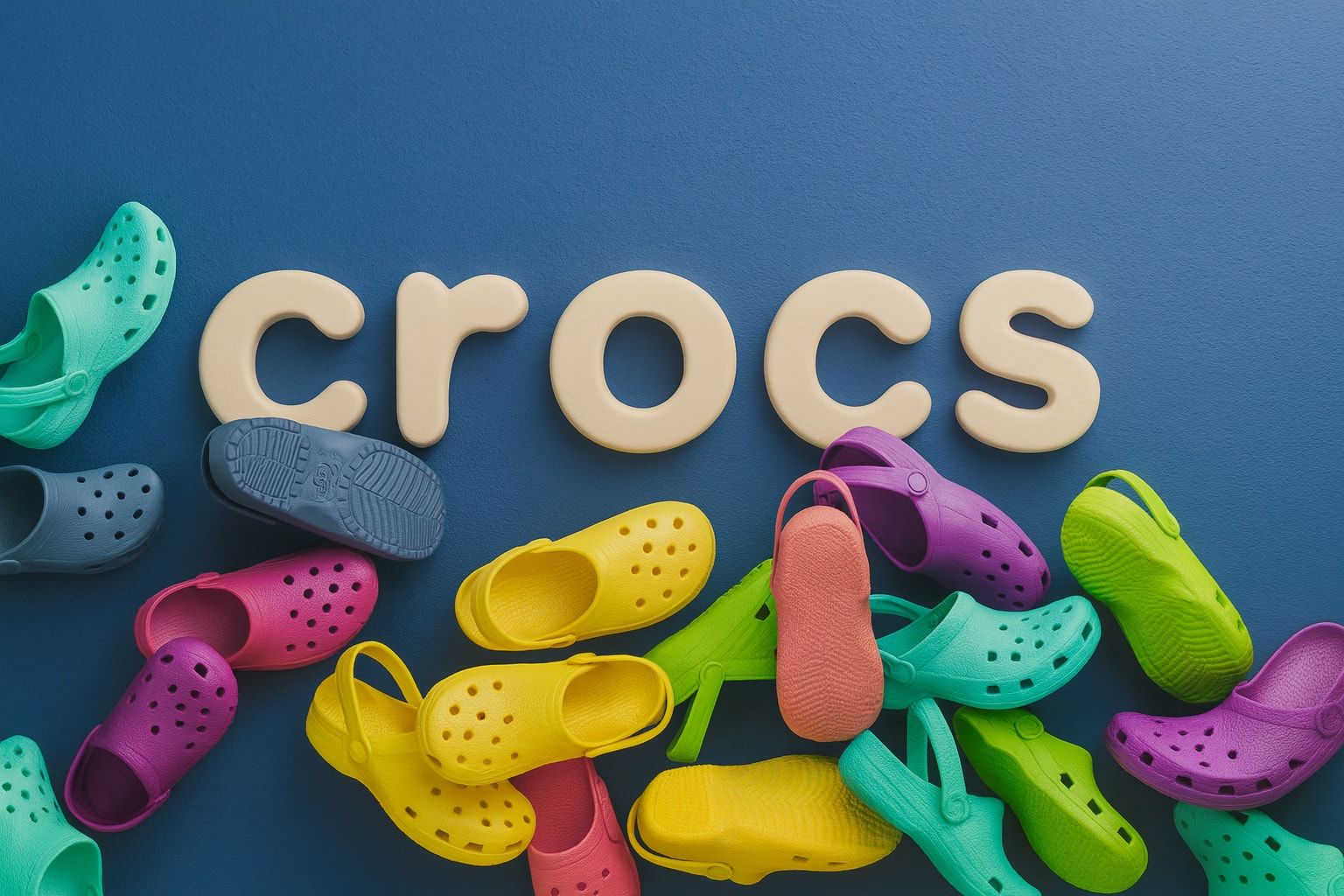- Crocs stock jumps after strong Q3 results: Crocs, Inc. (NASDAQ: CROX) surged about 7% on Oct. 30 after crushing third-quarter earnings forecasts [1] [2].
- Earnings beat expectations: Q3 revenue was $996.3 million (down 6% year-over-year but ~3% above estimates) and adjusted EPS $2.92 beat consensus by nearly 24% [3].
- Upbeat holiday outlook: Crocs issued surprisingly strong Q4 guidance (~$1.07 billion revenue) about 15% higher than analysts predicted [4], signaling optimism for the holiday season.
- Rebounding from a rough year: The stock’s post-earnings pop recoups some losses from a steep summer selloff – CROX remains ~40% below last year’s level amid earlier tariff and demand worries [5] [6].
- Mixed analyst views: Wall Street is cautious but not bearish – 10 analysts rate Crocs a Moderate Buy with an average 12-month target around $86 (ranging from $67 to $100) [7]. Bulls praise Crocs’ strong profits and brand strength, while others warn of continued headwinds like weak U.S. demand and a struggling HeyDude subsidiary [8] [9].
Strong Q3 Results Spark a Stock Surge
Crocs (CROX) stock jumped over 7% on Thursday after the foam-footwear maker reported better-than-expected third-quarter earnings [10]. The company’s Q3 revenue of $996.3 million, though down 6.2% from a year ago, beat analyst estimates by about 3% [11]. Adjusted net income came in at $2.92 per share, trouncing forecasts (23.7% above consensus) and indicating Crocs managed to outperform in a tough environment [12]. Management also surprised the market with an upbeat outlook for the holiday quarter: Q4 revenue is projected around $1.07 billion, roughly 15% higher than Wall Street’s expectation, along with solid profit guidance [13]. These strong results and guidance sent CROX shares rallying to around $91 by midday Thursday, as investors cheered the earnings beat and signs of resilience [14].
The Q3 report showed strength in Crocs’ core brand even as overall sales declined. The flagship Crocs brand’s revenues dipped a modest 2.5% to $836 million, while its smaller HEYDUDE shoe brand (acquired in 2022) saw a much sharper 21.6% drop to $160 million [15]. The company blamed softer wholesale demand for the decline, but noted direct-to-consumer (DTC) sales still grew slightly [16]. International markets were a bright spot as well – Crocs highlighted strong growth overseas that helped offset weakness in the U.S. [17]. “Our third-quarter performance was driven by disciplined execution against our brand strategies,” CEO Andrew Rees said, adding that results “came in ahead of expectations” and that Crocs is “working to re-gain momentum in the marketplace.” [18] The company also flexed its financial strength by repurchasing 2.4 million shares (using $203 million cash) and paying down $63 million in debt during the quarter [19] – moves that reflect confidence and helped boost investor sentiment.
Rebounding After a Rough Year
This week’s rally marks a partial comeback for Crocs stock, which has been battling headwinds throughout 2025. Back in early August, Crocs shocked the market by warning of “super‑cautious” U.S. consumers and new tariffs crimping sales – news that sent CROX plunging ~30% in a single day [20]. That summer sales warning, which included a forecast for a 9–11% revenue drop, was a stark reversal for a brand that had boomed during the pandemic’s comfort-wear craze. Shares hit their lowest level in almost three years after that announcement [21]. Crocs executives noted at the time there was “ample evidence” American shoppers had pulled back – foot traffic was down and consumers were delaying purchases amid rising prices [22]. They also cited the impact of the Trump administration’s new tariffs on imported materials, estimating a $40 million hit in the second half of 2025 due to trade policy changes [23]. Compounding the challenge, some in the fashion world wondered if the quirky “ugly shoe” trend that fueled Crocs’ meteoric rise was finally fading [24]. Crocs’ CFO even acknowledged a shift “back towards athletic footwear” among consumers, as rivals like Nike and Adidas benefit from renewed interest in sneakers [25].
Broader market trends magnified Crocs’ struggles. High inflation, rising interest rates, and a cooling labor market made shoppers more budget-conscious across the retail sector [26]. The result was a tougher climate for discretionary brands: Crocs wasn’t alone in warning of softening demand. In fact, footwear peers from Nike to Allbirds also flagged tariff pressures and cautious consumer spending in late 2025 [27] [28]. Athletic apparel makers like Under Armour trimmed their sales outlooks as well, citing the same headwinds [29]. By early October, CROX stock was down roughly 27% year-to-date and about 41% lower than a year prior [30]. The slide eroded over half of Crocs’ market value at one point. It wasn’t just external economics hurting the stock, either – Crocs’ HeyDude acquisition turned into a drag on results, with the casual shoe line underperforming expectations and seeing double-digit sales declines [31] [32]. Several big-name analysts reacted by slashing their targets on Crocs over the summer. For example, KeyBanc Capital cut its 12-month price target from $120 to $95 on August 8, and UBS lowered its target from $110 to $85 a few days later [33]. Bank of America trimmed its projection from $135 all the way to $99 (though notably maintained a “buy” rating) [34]. These across-the-board downgrades signaled Wall Street’s cautious outlook after Crocs’ stumble, contributing to the heavy selling pressure into the fall.
Analysts Weigh In on Outlook
After Crocs’ latest earnings beat, analysts and investors are debating whether this marks a turning point. Some market observers see reasons for optimism: despite the rocky year, Crocs remains strongly profitable and its core brand still enjoys global popularity. In fact, a few analysts suggest CROX may now be undervalued, noting the company’s hefty cash flows and continued international growth potential [35]. They point out that Crocs has been using its cash to buy back stock (a shareholder-friendly move) and that its iconic clogs retain a loyal fan base worldwide. “Crocs is a compelling long-term story”, one bullish Seeking Alpha analysis argued, highlighting improved margins and strategic partnerships in the works (from celebrity collaborations to new product lines) [36]. On average, Wall Street’s stance on Crocs is neutral-to-positive. According to TipRanks, 10 analysts currently cover CROX with 4 rating it a Buy, 5 a Hold, and 1 advising Sell – yielding a Moderate Buy consensus [37]. The average 12-month price target is about $86.60, roughly where the stock trades after its post-earnings jump [38]. Price forecasts range from a bullish high of $100 to a cautious low of $67 [39], reflecting a wide split in sentiment. In other words, some see significant upside if Crocs executes a turnaround, while others remain wary. “We believe both of our brands have greater potential,” CEO Andrew Rees insisted, emphasizing efforts to revitalize HeyDude and regain U.S. sales momentum [40].
At the same time, serious concerns temper the outlook. Sell-side analysts project Crocs’ sales will stay under pressure into 2026, with current consensus expecting revenue to decline slightly (~2%) over the next year [41]. Earnings are forecast to slip as well – Wall Street sees Crocs earning about $12.67 per share over the next 12 months, which would represent a 16% drop in EPS compared to the prior year [42]. These predictions indicate that demand headwinds haven’t disappeared [43]. U.S. consumers are still cautious on discretionary buys, and Crocs’ faux pas could still face fashion fickleness if the clog craze truly cools off. “Brands often experience cycles of popularity and decline,” one industry review noted, warning that companies must continuously reinvent themselves to avoid losing relevance [44]. Crocs’ leadership appears keenly aware of this. Rees highlighted new cost-cutting initiatives – an extra $100 million in savings targeted for 2026 on top of $50 million this year – aimed at preserving margins if sales growth remains sluggish [45]. The company is also fine-tuning its product mix and marketing, recently teasing fresh collaborations (for example, limited-edition clogs with pop culture themes) to stoke consumer excitement.
Challenges and Opportunities Ahead
Going forward, the big question is whether Crocs can sustain a true comeback. The tariff and inflation pressures that hurt 2025 results are still in play: higher import costs and pricey materials could continue to squeeze margins or force Crocs to hike prices at the risk of losing budget-conscious shoppers. The broader economic backdrop remains uncertain as well. However, Crocs’ latest guidance – calling for only an ~8% revenue decline in Q4, much better than the double-digit drop feared earlier – suggests the worst may be over in terms of sales contraction [46] [47]. If the company can hit that improved outlook, it would mean a return to single-digit growth on a constant-currency basis for the Crocs brand next quarter, which management hopes will “re-gain momentum” into 2026 [48]. Key to this will be reviving the HEYDUDE brand. Crocs paid $2.5 billion for HeyDude in 2022 to expand beyond its flagship clogs, but the line’s 20%+ sales slump in Q3 shows integration has been bumpy [49]. Executives have indicated plans to stabilize HeyDude via fresh designs and marketing, noting that even a modest turnaround there could boost overall growth [50]. Meanwhile, Crocs will lean on its core franchise – the classic clogs and sandals – which continues to perform well globally (particularly in Asia and Europe).
Competition in casual footwear is heating up, so Crocs must execute carefully. Rivals like Skechers and Birkenstock are vying for comfort-shoe shoppers, while sportswear giants (Nike, Adidas) are capitalizing on a trend “back towards athletic” styles [51]. The good news for Crocs is that the comfort footwear trend that made it a pandemic winner hasn’t vanished; consumers still embrace quirky, comfy shoes, just with higher expectations for novelty and value [52]. By innovating with new collaborations (e.g. limited-edition Crocs with popular media franchises) and expanding into adjacent products, Crocs aims to stay culturally relevant. The brand’s recent partnerships – from M&M’s candy-themed clogs to anime-inspired designs – show it’s leveraging its pop-culture appeal to drive demand [53]. If these efforts bear fruit and macroeconomic pressures ease, analysts say CROX stock could have room to run. “A successful revitalization of HeyDude, coupled with continued strong performance of the core Crocs brand, could see the stock rebound as investor sentiment improves,” observed one market commentary [54]. Conversely, if consumer spending remains weak and HeyDude continues to lag, CROX may struggle to hold its recent gains.
For now, investors appear cautiously optimistic. Crocs’ Q3 earnings beat has provided a much-needed confidence boost after a difficult year. The company is demonstrating that it can still deliver profits and outmaneuver lowered expectations even in a tough climate. With shares still well below their peaks, any further good news – whether an uptick in holiday sales, easing tariff burdens, or successful new product buzz – could fuel additional upside. However, the road ahead likely won’t be smooth. As the rubber clogs pioneer navigates changing consumer tastes and economic crosswinds, management’s challenge will be to show that Crocs’ growth story isn’t over. The next few quarters (including the crucial holiday season) will be pivotal in proving whether the Crocs comeback is real or just a temporary bounce. Investors will be watching closely for evidence that the colorful clogs can keep their footing in 2026 and beyond.
Sources: Crocs Q3 earnings release [55] [56]; StockStory analysis [57] [58]; Associated Press/Times Union [59]; ts2.tech (MarketMinute) industry report [60] [61] [62]; The Guardian [63] [64]; Business of Fashion/Guardian [65] [66]; TipRanks consensus data [67]; GuruFocus/Yahoo Finance [68].
References
1. stockstory.org, 2. stockstory.org, 3. stockstory.org, 4. stockstory.org, 5. markets.financialcontent.com, 6. ts2.tech, 7. www.tipranks.com, 8. markets.financialcontent.com, 9. www.prnewswire.com, 10. stockstory.org, 11. stockstory.org, 12. stockstory.org, 13. stockstory.org, 14. stockstory.org, 15. finance.yahoo.com, 16. www.prnewswire.com, 17. www.prnewswire.com, 18. www.prnewswire.com, 19. www.prnewswire.com, 20. ts2.tech, 21. www.theguardian.com, 22. www.businessoffashion.com, 23. www.businessoffashion.com, 24. www.businessoffashion.com, 25. www.businessoffashion.com, 26. www.businessoffashion.com, 27. ts2.tech, 28. ts2.tech, 29. ts2.tech, 30. markets.financialcontent.com, 31. markets.financialcontent.com, 32. www.prnewswire.com, 33. markets.financialcontent.com, 34. markets.financialcontent.com, 35. markets.financialcontent.com, 36. seekingalpha.com, 37. www.tipranks.com, 38. www.tipranks.com, 39. www.tipranks.com, 40. www.prnewswire.com, 41. stockstory.org, 42. stockstory.org, 43. markets.financialcontent.com, 44. markets.financialcontent.com, 45. www.prnewswire.com, 46. www.prnewswire.com, 47. www.prnewswire.com, 48. www.prnewswire.com, 49. www.prnewswire.com, 50. markets.financialcontent.com, 51. www.businessoffashion.com, 52. markets.financialcontent.com, 53. markets.financialcontent.com, 54. markets.financialcontent.com, 55. www.prnewswire.com, 56. www.prnewswire.com, 57. stockstory.org, 58. stockstory.org, 59. www.timesunion.com, 60. markets.financialcontent.com, 61. markets.financialcontent.com, 62. markets.financialcontent.com, 63. www.theguardian.com, 64. www.businessoffashion.com, 65. www.businessoffashion.com, 66. www.businessoffashion.com, 67. www.tipranks.com, 68. finance.yahoo.com







